A-20G in Soviet MarkingsBy Michael Leduc |
I have always liked the Douglas A-20. It is one of those U.S. pre-war designed aircraft along with the Curtiss P-40 and Bell P-39 where a curvy and esthetically pleasing shape seemed as important as brute efficiency. The A-20 was a versatile aircraft as well, used by several airforces and in mutiple roles. One source suggests that it should sit alongside the DeHavilland Mosquito and The Junkers Ju88 as the important twin-engined aircraft of the war.
In particular I have also been interested in use of the A-20 by the VVS. This is partially due to unusual fact that they were the single largest user of the type, yet there still seems to be only a minute bit of information. That said, I am indebted to Alexander Ruchkovsky in Latvia and also those posters in the rec.models.scale newgroup for pointing me in the right direction. If you like the Havoc, I’d also enthusiastically endorse the AJ press monograph. Although the text is in Polish, it has many photos and much information I doubt you could find elsewhere.
 The
aircraft modeled is an A-20G-35-DO Torpedo Bomber of the Baltic Fleet. The pilot
was Maj. F.Orlenko, The Navigator (Bombadier?) was F.T. Prekin and the Radio
Operator was V.V. Bykov. (Again my source is in Polish so I apologize for my
lack of info). It appears that this was shipped in the six-gun nose configuration
but then converted in the field with a glazed panes to make the aircraft a suitable
torpedo bombing platform. According to Alex, the aircraft was capable of carrying
two torpedos, but usually one torpedo was carried at a time on an off center
rack. (I used two for purely aesthetic reasons.)
The
aircraft modeled is an A-20G-35-DO Torpedo Bomber of the Baltic Fleet. The pilot
was Maj. F.Orlenko, The Navigator (Bombadier?) was F.T. Prekin and the Radio
Operator was V.V. Bykov. (Again my source is in Polish so I apologize for my
lack of info). It appears that this was shipped in the six-gun nose configuration
but then converted in the field with a glazed panes to make the aircraft a suitable
torpedo bombing platform. According to Alex, the aircraft was capable of carrying
two torpedos, but usually one torpedo was carried at a time on an off center
rack. (I used two for purely aesthetic reasons.)
The kit is the AMT/Ertl A-20G kit in 1/48 scale. This is a very nice kit with good detail and few fit problems. It is now unfortunately out of print but still seems relatively common. To make the semi-glazed nose I swiped the parts from the A-20B/C and did my best to remove the scribed panel lines. The profile of the nose tip is not perfect, but I feel this is easiest way to go. Lest you think you’d be wasting an out of print kit by stealing the nose, there are two in the A-20B/C kit-- one for each version. A more compelling option is to use the solid nose from the A-20G to make a 20mm Cannon equipped A-20G-1. This configuration was found to be unsuitable for the USAAF usage so virtually all of these were sent to Russia via Lend-Lease. My future plans are to build an A-20G-1 VVS Nightfighter which also utilized another VVS custom job, a complex "swinging cannon" belly pack in the bomb bay—not totally unlike the "Jazz Music" system used by Luftwaffe night fighters…stay tuned.
General Construction Notes:
 The
torpedos are from Flightpath and were originally intended for the Fairey Swordfish,
but looked similar enough for me. The simple looking racks were made from plastic
card and strip. I folded the life raft behing the cockpit from lead foil as
I didn’t feel like wasting my True Details wheel set. As an aside some have
criticized the wheels in this kit and suggested that the resin wheels are the
way to go. I actually feel that if you sand down the tread considerably the
kit wheels look great. As they are, they have an unrealistic "dune buggy"
like tread quality. In any event, the True Details wheels are of the spoked
variety and all Havocs, save the very latest versions had hubcaps. Other than
a photo-etched seatbelt everything else is from the kit. As I mentioned, the
moulded detail in the cockpit is quite good.
The
torpedos are from Flightpath and were originally intended for the Fairey Swordfish,
but looked similar enough for me. The simple looking racks were made from plastic
card and strip. I folded the life raft behing the cockpit from lead foil as
I didn’t feel like wasting my True Details wheel set. As an aside some have
criticized the wheels in this kit and suggested that the resin wheels are the
way to go. I actually feel that if you sand down the tread considerably the
kit wheels look great. As they are, they have an unrealistic "dune buggy"
like tread quality. In any event, the True Details wheels are of the spoked
variety and all Havocs, save the very latest versions had hubcaps. Other than
a photo-etched seatbelt everything else is from the kit. As I mentioned, the
moulded detail in the cockpit is quite good.
Most of the decals were from various Aeromaster sheets. The lettering, kill markings and a few other insignia were hand painted onto clear decal film. I will say that the wingwalk markings were from the kit and were a big problem—both out of register and "rubbery". They just didn’t seem to want to settle down at all and responded poorly to both of my decal setting solutions. I built another of these kits when it was released and I seem to remember the kit decals being much better—oh well.
 The
paint scheme is standard US Olive Drab over Neutral Grey with a camouflage pattern
of "tmava zelena" according to my text. (Black Green? Violet Green?)
I guessed at "Black Green" and sprayed RLM 70 Schwartzgrun. (I hope
someone will correct me if I am wrong.)
The
paint scheme is standard US Olive Drab over Neutral Grey with a camouflage pattern
of "tmava zelena" according to my text. (Black Green? Violet Green?)
I guessed at "Black Green" and sprayed RLM 70 Schwartzgrun. (I hope
someone will correct me if I am wrong.)
Weathering was done with a general spray of Tamiya smoke and a wash of Raw umber and black artist oils. In hindsight it appears maybe a little overdone, but along with my photography, weathering is an area I am still working on.
In conclusion, this was a very satisfying project of an A-20 of a different color. I have several AMT kits awaiting me on the shelf and would love to do more VVS subjects. If anyone is interested in exchanging tips and more information on the Havoc please contact me. I am particularly interested in photos of aircraft painted in winter distemper and those modified with the "ball turret".